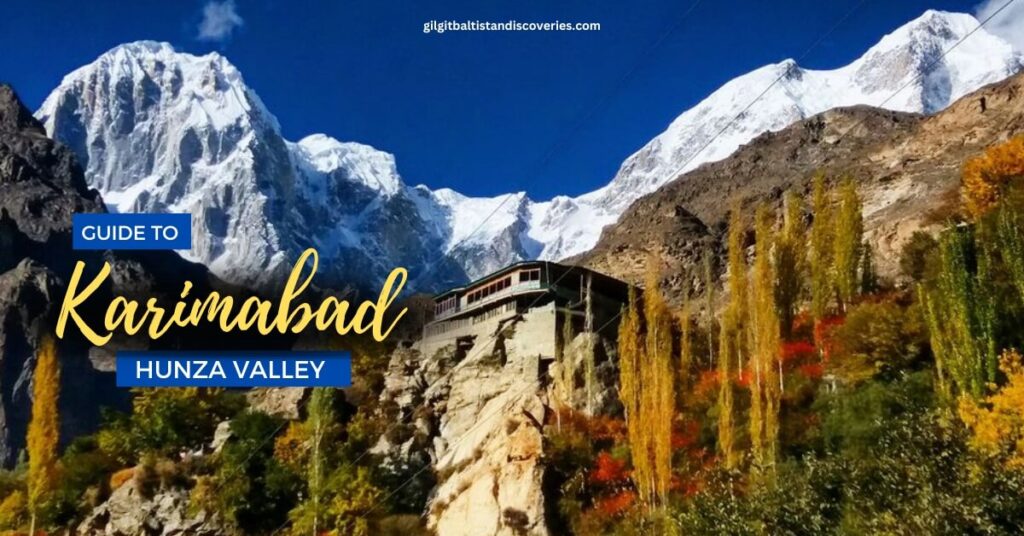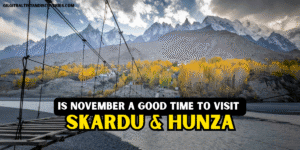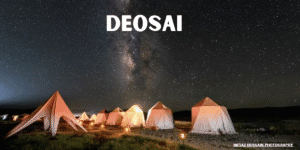Table of Contents
ToggleIntroduction to Karimabad and Hunza
Nestled within Pakistan’s Hussain Karakoram Range, Karimabad and the vast Hunza Valley look almost like a dream. Picture towering snow-capped mountains reaching for the sky, vibrant green valleys, and ancient rivers winding through this magical landscape. Karimabad, also known as Baltit (Kareemabad), is celebrated for its scenic views, deep historical roots, and the hospitality of its warm and welcoming residents. It belonged to the Kashmir region. Discover Karimabad and Hunza – Your Ultimate Karakoram Adventure.

Historically, Karimabad played a significant role as a key settlement. The town is framed by snow-capped peaks such as Rakaposhi, which rises to about 25,000 feet (7,600 meters), and is surrounded by glaciers like Alter Nala. This town also consists of deep gorges. Access to Karimabad is mainly through the hill road from Gilgit.
This guide will explain everything you need to know about Karimabad and Hunza, from the ideal times to visit and local traditions to essential travel tips. Embark on an unforgettable journey into this enchanting region!
Natural Wonders of Karimabad
Towering Peaks and Breathtaking Panoramas
Karimabad’s natural beauty is a visual delight. The towering peaks of Rakaposhi Nagar (Opposite) Nagar Valley, Alter, and Ladyfinger dominate the landscape, each with unique allure. Rakaposhi, often called the “Hidden Peak,” is a breathtaking sight with snow-covered slopes and steep peaks. Alter Peak, with its dramatic, rugged terrain, creates a sense of grandeur in the region. With its slender, needle-like form, Ladyfinger Peak stands as a striking counterpoint to the towering giants that loom over the Hunza River.
Shimmering in brilliant turquoise, the Hunza River breathes life into the valley. Its vivid blue waters trace a bold, meandering ribbon through the landscape, standing against the lush green fields and rugged peaks.
Also Read This: Beautiful Places to Visit in Hunza Gilgit Baltistan Pakistan
Exploring Karimabad’s Green Spaces
Stunning green fields and terraced landscapes await around Karimabad. They are visually stunning, so they play host to a myriad of flora [and] fauna species. The vibrant wildflowers, flourishing orchards, and crystalline terraced fields humming with life will envelop you as you wander this wonderland.
Wildlife and Flora
A lively sanctuary of an abundant variety of greenery in wide range, Karimabad Thus, the area host an array of rare and endangered species like the gregarious Himalayan ibex to mysterious snow leopards. Take pleasure in seeing golden eagles and Himalayan griffons, mainly by bird watchers. The forest is rich with a fantastic combination of blooming roses, pansies, lilies, zinnia, and cosmos flowers that are found side by side amongst the fruit trees crowding together apples, apricots, walnuts, mulberries, all graced by hanging willows.
Pine and poplar trees
Fauna recorded in the village include ibex (Capra (genus), ducks, red-striped fox, snow leopard (Panthera ancia sin. Ancia ancia), markhor (Capra falconeri) (wild goat), Marco Polo sheep (Ovis amon polli ), and yaks (Bos grunniens and Bos mutus).
Hiking and Adventure in Karimabad Hunza
Popular Hiking Trails
Many trekking paths are available for all levels of trekkers, from beginners to professionals in Karimabad. An optional afternoon walk to visit Baltit, which is the former capital of Hunza, historically established for over 750 years, ending in the mid-20th century. These trails offer stunning vistas and a deep dive into the area’s rich history. After Pakistan’s independence in 1947, Hunza joined Pakistan voluntarily, and the capital was relocated from the Blyth area to the lower hills. The new town of Karimabad emerged along the Karakoram Highway, marking a new chapter in the region’s development. It has developed as a tourist destination. Along with several shopping complexes dealing with handicrafts, hotels, restaurants, and travel agencies.
Ulter Base Camp Trek
The trek to Ulter Base Camp is one of the most rewarding adventures in Karimabad. The trail offers challenging terrain but is worth the effort. As you ascend, you will be treated to stunning views of Alter Peak and the surrounding mountains. The trek ends at the base camp, where the scenic views are nothing short of breathtaking.
Nearby Adventure Activities
Karimabad is a hotspot for adventure beyond hiking. For thrill-seekers, here are some top activities:
River Rafting: Ride the exhilarating rapids of the Hunza River while enjoying spectacular views.
Mountain Biking: Explore rugged trails and experience the stunning landscape from a dynamic new angle.
Rock Climbing: Challenge yourself on the region’s rocky outcrops, which offer climbing routes for all skill levels. Alter Nala water channels (seven west-flowing and five east-flowing) are used at various levels for irrigation from headworks at the take-off of the Nala and on its way across the Hunza Valley. It is also a tourist attraction. Some channels pass through Karimabad city. The water flowing in the canal has a velvety color due to fine mica particles.

Historical and Cultural Heritage
Baltit Fort
Many locals still refer to Karimabad by its former name, Balteet. In the 17th century, the daughter of the Balti ruler, the wife of Mir Eishu II (the great-grandson of the Greeks and a legendary ruler), came to live in Hunza. The fort was built in Balti style by the artisans he brought. It was renewed during the reign of Aisha II’s son. Mir Nazim Khan decorated it with wallpaper, curtains, fireplaces, balconies, and stained glass windows.
Exterior Of The Fort:
The exterior of the fort was painted white. He also built a raised platform on the roof to hold council meetings. Once the capital was shifted to Karimabad, the fort was stripped of all its furnishings and decorations. Nazim Khan’s son moved to Karimabad in 1945. The fort, in dilapidated condition as of 1984 Between 1990 and 1996, was meticulously restored to allow her original layout yet seismically improve the structure.
In a beautiful valley in the far north of Pakistan, Karimabad is located on the western bank at 8,200 feet (2.500 meters] above sea level, overlooking the Hunza River. The town is known for its stone-walled buildings and steeply pitched roofs. Historically, Karimabad is served by the city set against snow-capped mountain peaks like Rakaposhi, which rises to about 25,000 feet (7,600 m). It is surrounded by glaciers like Alter Nala. This town also consists of deep gorges. Access to Karimabad is mainly through the hill road from Gilgit.
Restoration and Preservation
The fort has been extensively restored to maintain its historical integrity. Today, the fort functions as a museum, offering visitors an in-depth look at Hunza’s history and culture. Touring its corridors and ascending its watchtowers provides an engaging view of the lives of its former residents.
Altit Fort
Altit Fort, older than Baltit, offers another interesting historical experience. Its strategic location and ancient architecture reveal a lot about Hunza’s past. The fort’s wooden balconies and traditional design elements starkly contrast with the more recent Bullet Fort, showing the evolution of architectural style over time.
Cultural Significance
Both forts are more than historical monuments; they represent the heart of Hunza’s cultural heritage. They directly connect to the past and are vital for appreciating the region’s history and traditions.
Cultural Immersion and Local Life
The Warm-Hearted People of Hunza
Visiting Karimabad is always one of the highlights ever as one gets to meet the residents of Hunza. They are known for their hospitality and friendliness, therefore making them welcome visitors like family members. Their authentic friendliness and eagerness to share their culture and traditions are central to the authentic Hunza experience. Most of the people of Hunza are Ismaili Muslims. The state’s official language was Persian until 1947 when Urdu replaced it. The common language of Hunza is Brushaski, while Wakhi and Shina are spoken in Upper Hunza and Lower Hunza, respectively.
Traditional Hospitality
On a typical visit, you could be welcomed into a local home where steaming tea and traditional snacks greet you. It’s not just a social custom but how people here open up to each other to make friends with tourists in the long run. The Queen Victoria Monument stands on the rock face at the rear end of Karimabad. It can be reached by trekking for about an hour through irrigation canals, a polo ground, an old watch tower, and a narrow path strewn with rocks. It is based on a rock face and was built by Nazim Khan. In the local Brushaski language, it is called “Malkamo hunter” (ma-li-ka-mo shi-ka-re).
Festivals and Celebrations:
Festivals are a big part of Hunza’s cultural scene. With its many vibrant traditions, there are several throughout the year.
Navroz Festival:
Novruz, the Persian New Year, is enthusiastically celebrated in Hunza. The festival signifies the start of spring and includes traditional music, dance performances, and festive feasts. It’s an occasion of excitement when people come together, and tourists have an opportunity to see what local celebrations are like firsthand.
Also Read This: Travel Guide to Chilas, Gilgit | Best Places to Visit Chilas
Spring Blossom Festival
The Spring Blooming Festival is another highlight of the local calendar. This festival celebrates the blooming of flowers and the arrival of warmer weather. It includes traditional dances, musical performances, and community gatherings. The festival is a wonderful way to experience the local culture and enjoy the beauty of the blooming landscape.
Culinary Delights of Hunza
Traditional Dishes
Hunza Cuisine
Hunza’s cuisine combines local ingredients and traditional methods. Don’t miss these dishes.
Chapshuro: A flaky pastry stuffed with spicy vegetables and meat, usually served with yogurt or sauce. It’s a popular and satisfying local favorite.
Dawdo is a soothing noodle soup made with hand-cut noodles in concentrated stock and new herbs and spices. It is best for cool mountain evenings.
Hunza Apricots are popular for their extra-sweet flavor and high quality, and they provide nourishment to people who eat them locally.
Dining Experiences
Dining in Hunza is an experience that you can never afford to forget. Be it a family-owned eatery or even a guest house where traditional foods are served, one can still consume local cuisine while at the same time giving back to the community. For example, eating from these places will not only help one appreciate real Hunza taste but also support local businesses and sustain conventional food rituals.
Travel Tips and Practical Information
Best Time to Visit: The spring period (April-May) and autumn season (September-October) are ideal. In these two seasons, visitors can enjoy beautiful views and gentle weather conditions, with blooming flowers during springtime and bright colors during autumn.
Getting There: Karimabad can be reached either by traveling through the stunning Karakoram Highway or by flying into Gilgit and then driving up to It. Both options offer stunning views.
Accommodation Options:
– Luxury Hotels: Serena Hotel Hunza provides upscale accommodations with breathtaking views.
– Mid-Range Hotels: Hunza View Hotel offers comfortable rooms and excellent mountain vistas.
– Guesthouses: For an authentic experience, stay in local guesthouses. These provide a unique stay and support the community.
Respecting the Environment:
To help preserve Karimabad’s natural beauty:
– Leave nothing behind: you should carry all your garbage and avoid throwing it around.
Waste Reduction: go for items that can be used again and lessen the number of plastics made for single use.
– Support Local Conservation: Engage in conservation efforts and respect wildlife.
Supporting Local Communities:
Buy crafts from artists and eat in family restaurants, as this will promote the local economy.This helps sustain traditional crafts and boosts the community.
Exploring Beyond Karimabad:
The Hunza Valley offers more than Karimabad. Explore its stunning landscapes and rich cultural experiences for a full appreciation of the region.
Exploring Beyond Karimabad: The Hunza Valley
Visit Ganish and Aliabad
Ganish and Aliabad are charming villages that provide glimpses of Hunza’s traditional life. Ganish, with its historic architecture and narrow streets, provides an interesting contrast to the modern aspects of Karimabad. The central town of the Hunza Valley, Aliabad, provides additional amenities and serves as a gateway for further exploration.
Located at an elevation of 2228.75 m (7312.17 ft) above sea level, Aliabad has a subarctic, severe winter, no dry season, and cool summer climate (classification: Dfc). The annual temperature of the district is -9.76ºC (14.43ºF) and is -30.65% below the Pakistan average.
The Hunza Valley has a diverse religious history, with several historic religious sites, such as the ancient watch towers at Ganesh Village and the Baltat Fort on the top of Karimabad, built by the Mirs about 800 years ago. It is a landmark for Hunza and Altait. Is. Fort (at the bottom of the valley).
Trek to Passu Cones
Passu Cones
Nature lovers and photographers can never resist seeing the pyramid-shaped peaks of the Passu Cones. Taking a trek to these iconic formations provides not only beautiful vistas but also an opportunity to get close and personal with the wild terrain of this region. Passu: From a short, easy trail of around 30–45 minutes directly from the village to the edge, or you can do a longer, tougher route starting beside Karakoram highway near Hussainabad Village.
Climbing Opportunities
Hunza is a favored climbing spot, with many different accessible routes for beginners to advanced users. Home to some of the highest peaks in North America and a good dose of truly rugged terrain, it’s no wonder it kicks off this list as an obvious choice for climbers both expert enough to take on Denali and adventurous novices simply looking to earn their mountain legs.
Adventure Tourism Trends
Adventure Tourism has increased ten times over the last decade, so much so that Gilgit-Baltistan is known to one and all now! Thanks to a wealth of pristine natural environments packed with cycling and hiking opportunities, the area is emerging as an adventure destination in its own right. It reflects a widening emphasis from (relatively) safe hiking groups to what is meant for higher and sturdier — a trendline that matches the increasing siren call of high-altitude adventure.
Shopping Attraction Karimabad hosts several local handcraft, gem, and jewelry factories that make Karimabad a shopper’s paradise. Buy antique items and hand-crafted and unique souvenirs, including the Hunza Cap. Markets are such picturesque places and wonderful locations for buying dry fruits, whether nuts or not, which are more popular. FYI: You would spend quite a lot if you go there, so better to bring your wallet! Prospective
Eco-Friendly Projects The Hunza
Hunza keeps its natural beauty intact with several practices, which include reductions in plastic use, water conservation, and renewable energy education. This kind of initiative is very important to support sustainable tourism and environmental conservation.
How Visitors Can Help
Residents and guests can help Hunza remain sustainable into the future by choosing green hotels, reducing their travel emissions, and observing local customs. This will also aid conservation efforts, which is another way of ensuring the place’s beauty stays intact for many generations to come.
Stargazing in Karimabad
The Night Sky Experience
And stargazers will absolutely lose their minds at the Karimabad sky, which I can confirm is one of, if not THE clearest, unpolluted skies you’ll ever see. A beautiful night, without light pollution, gives you a starry night that does not exist anywhere else. The full glory of the night sky in this part of the world is truly awe-inspiring and makes you feel that perhaps, somehow, we are actually better linked with our universe. The local bands will also perform at cultural events to enrich your journey, our traditional dancing in the perfect way for us and you, as well as their music interpretation. Advanced and Online Booking for these cultural programs in Hunza Valley.
Also Read This: Everything You Need to Travel the World
Tips for Stargazing
– Seek Out Darkness: Select an area away from artificial light to ensure the stars are visible.
– Carry Equipment: The human eye is an outstanding instrument, but a telescope or binoculars can improve your experience.
Weather: You need clear skies to stargaze, so check the weather before you try any of these.
Conclusion: The Charm of Karimabad
Karimabad and the Hunza Valley are more than just another travel spot…they offer moments that will hang onto your consciousness forever. They are unique because of their stunning landscapes, great history, lovely people, and tasty food. Karimabad and Hunza have it all if you want adventure, tranquillity, or cultural interaction. Spring 16: Neatly pack your bags. Experience the Wonders of Hunza with an open heart and treasure every moment in breathtaking views that will stay with you forever.







